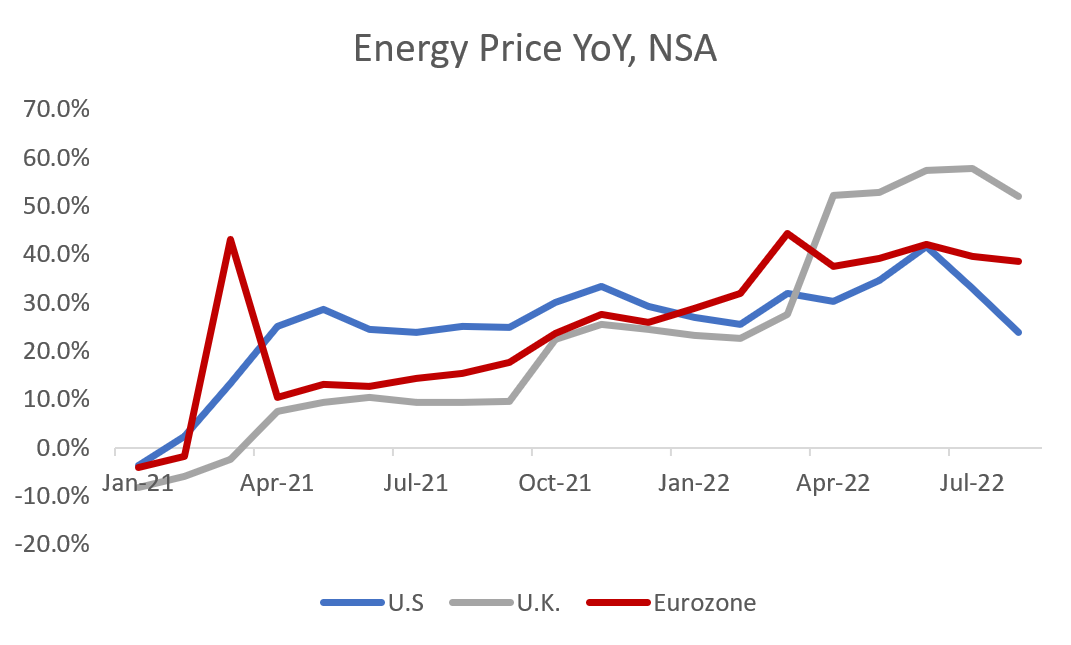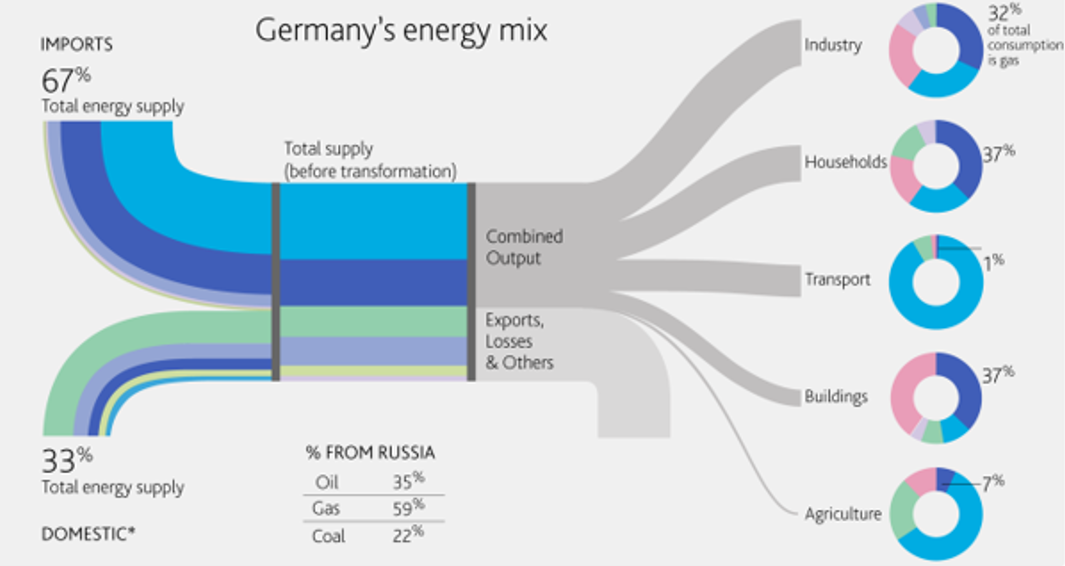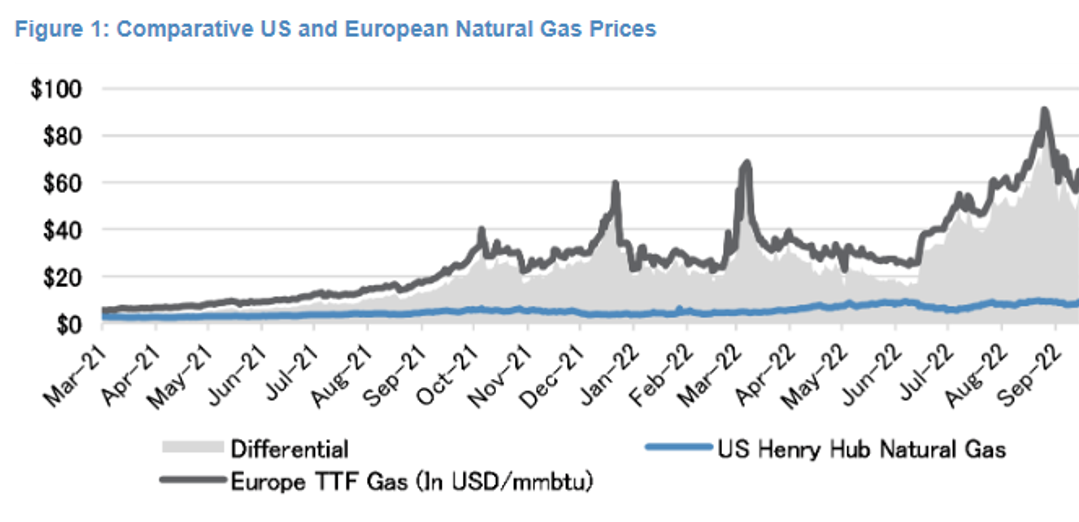
Winter is Coming: The Risk of Energy Shortages in Europe
How Russia’s halt on the Nord Stream 1 pipeline may lead to energy shortages in Europe
Co-authored by: Matthew Paniati
As the US economy faces high inflation, slowing growth, and aggressive monetary policy, another macroeconomic threat has presented itself overseas. On August 31st, 2022, Russian-controlled Gazprom PJSC announced an indefinite halt on natural gas flows with the Nord Stream 1 pipeline, adding to the already strong energy price pressures in Europe. A month later, The North Atlantic Treaty Organization (NATO) accused Russia of sabotaging the Nord Stream 1 and unfinished Nord Stream 2 pipelines which further escalated tensions. While energy prices rose globally following Russia’s invasion of Ukraine, Europe was especially impacted due to their reliance on Russian energy. Russia accounted for 30% of Europe’s oil imports and 40% of Europe’s natural gas imports1 prior to the invasion, with about half of this gas coming from Nord Stream 1. In particular, Germany—Europe’s largest economy—received nearly 60% of its natural gas from Russia prior to the invasion of Ukraine. A complete cessation of this energy source begs the question: Will Europe be able to maintain an adequate supply of energy this winter?

Source: Bloomberg
To mitigate risks of further supply shocks from the region, European companies have taken steps to reduce their dependency on Russian energy. In July, European Union (EU) members agreed to voluntarily reduce their use of natural gas by 15% between August 2022 and March 2023.2 In addition, European countries have increased LNG imports from other countries, provided government support such as price caps to put downward pressure on energy prices, and switched to alternative fuels where possible. As a result, Northwestern Europe’s gas storage levels were ahead of target in early September 2022, meeting 87% capacity, and will likely be approaching their 94% goal by November 2022.3 Moreover, Germany’s reliance on Russian gas has been cut in half, and has managed to fill its gas storage to similar levels.4 As a result of these efforts, Europe is better prepared for energy shortages as the EU looks to achieve energy independence from Russia by 2024.

Germany’s gas storage is now more than 80% full.

Source: Gas Infrastructure Europe, Moody’s
Although Europe is thus far on track to meet its energy storage targets before the winter, the region remains exposed to a “worst-case scenario” in which it is completely cut off from Russian energy, resulting in dramatic energy shortages. Germany’s particularly high reliance on Russian gas leaves their long-term energy storage targets at greater risk than some other countries in Northwestern Europe. Despite plans to start up four floating LNG facilities by 2023, this will most likely not help Germany in the short-term.
Moreover, a particularly harsh winter could lead to energy rationing to ensure European households have heat, likely at the expense of the industrial sector. This could put stress on storage levels for the following winter should Europe fail to adequately find alternative sources of energy by that time. A forced rationing of gas would almost certainly exacerbate the challenges facing Europe, which is already on the precipice of recession. As a result, it will be important to monitor the situation to gauge if Europe’s economy can run at optimal levels through the winter.
The risk of energy shocks and rationing is highest for more capital-intensive industries, especially in countries that are more reliant on Russian gas. As previously mentioned, Germany is a large economy with heavy reliance on Russian gas and other energy imports, though Italy also has notable exposure.
Chemical Sector: By sector, chemical companies are heavy users of natural gas and thus may be forced to lower their output in the event of rationing. Moreover, prolonged upward price pressures could reduce demand as persistently high inflation weathers consumers’ ability to cover increasing energy costs.
Automotive Sector: The automotive sector, which has already experienced stress from snarled supply chains and semiconductor shortages, could see greater weakness in the event manufacturing capacity declines. The sector’s concentration in Germany, which accounts for nearly a quarter of European auto production, is also a negative in a downside scenario.5
In contrast, similar sectors that are outside of Europe have a relative advantage due to lower energy costs putting further pressure on European credits. Even in non-energy intensive sectors, the risk of higher energy costs may ultimately eat into consumers’ spending power which could reduce demand across the board.

Source: J.P. Morgan estimates. Bloomberg Finance L.P.
Financials are relatively less exposed to changes in energy prices but will likely be impacted from the pressure put on households and businesses.

Source: Barclay’s Research
Corporate Loans: On the corporate loan side, the primary question is one of sectoral loan exposure. Banks with loan portfolios geared towards energy intensive companies, particularly those with weak fundamentals, are the most at-risk. The ECB estimates that such exposure accounts for 3.8% of European banks’ total corporate lending. Much of this is likely concentrated in Italy, along with Central and Eastern Europe. According to Moody’s, the Italian banking systems’ gross lending exposure to the manufacturing sector alone is ~120% of tangible common equity (i.e., the first layer of loss-absorbing capital), while Austria’s is 81%. Germany is also noteworthy due to the presence of Commerzbank, which is the most concentrated European lender to energy-intensive industries.

Source: European Banking Authority, Moody’s
Housing Market: On the household side, the risk is more indirect. Ultimately, changes in energy prices are unlikely to cause a crisis in European mortgage markets. However, the secondary impacts on the macro economy could be significant. The combination of rising interest rates, lower economic growth, and a weakening of the labor market could potentially put pressure on regional housing prices and lead to higher mortgage delinquency rates. Moreover, banks could see deterioration in their unsecured consumer lending (such as credit cards) if government support measures prove insufficient in supporting consumers’ debt servicing capacity.
Bank Exposures: Banks active in the derivatives markets face additional risks. In the commodity derivatives market, liquidity has started to seize up as utilities (which use the market to hedge their operations) have been hit with widespread margin calls amidst the run-up in prices. The amount of cash needed to meet the calls is significant, ~€1.5T according to Norwegian energy group Equinor. This is well in excess of the utilities’ working capital which runs the risk that, if left unsupported, banks may have to sell assets at steep losses or see their positions closed out. This in turn poses some counterparty risk to banks active in the market, as well as credit risk to those with underlying loan exposure to utility companies. Fortunately, given their public importance, several countries have announced plans to provide support or even nationalize affected utilities, helping to reduce the risk to these banks.
UK Markets: Finally, the recent turmoil in United Kingdom (UK) markets is illustrative of the risk posed by large-scale fiscal stimulus in response to the energy crisis. The rapid rise in gilt yields following the UK government’s stimulus announcement triggered forced sales by pension funds to meet margin calls, resulting in a downward spiral in markets that was quelled only by the Bank of England’s announcement that it would restart its purchases of government bonds. Given the scale of stimulus EU governments are engaged in (~€500B according to Beugel), there is an acute risk of a similar event occurring on Europe’s mainland. Such an event could inhibit market functioning, resulting in asset losses and stress in funding markets.
In short, while Europe has fared well thus far with its current energy challenges, a further hit to supply could lead to or exacerbate a recession, which could put pressure on credits. Given the uncertainty surrounding this risk, as well as possible spillover effects, investing in high-grade credits may be an important step toward principal protection. In addition to looming fears of energy shocks, the global macro environment is also characterized by high inflation and rapid central bank tightening, both of which act as headwinds to economic growth. Given this, high-grade credits provide two key advantages:
- First, high-grade corporates tend to benefit from geographic diversification, which may help to mitigate risks tied to one particular region
- Second, these credits typically maintain healthy balance sheets, which may provide a level of support as central bank tightening increases the cost of debt.
1https://markets.jpmorgan.com/#research.article_page&action=open&doc=GPS-4073189-0/
3https://markets.jpmorgan.com/#research.article_page&action=open&doc=GPS-4206796-0
4 https://www.weforum.org/agenda/2022/08/energy-crisis-germany-europe
5https://markets.jpmorgan.com/#research.article_page&action=open&doc=GPS-4206796-0
Please click here for disclosure information: Our research is for personal, non-commercial use only. You may not copy, distribute or modify content contained on this Website without prior written authorization from Capital Advisors Group. By viewing this Website and/or downloading its content, you agree to the Terms of Use & Privacy Policy.



